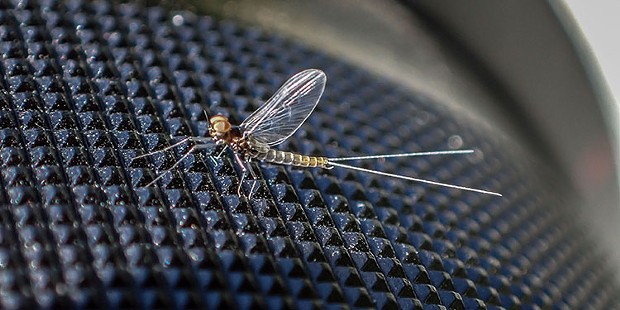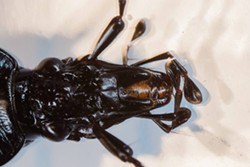[
{
"name": "Top Stories Video Pair",
"insertPoint": "7",
"component": "17087298",
"parentWrapperClass": "fdn-ads-inline-content-block",
"requiredCountToDisplay": "1"
}
]
Ground Beetles
Tip over a rock and you'll likely encounter something. Frequently, you'll see a black beetle a little smaller than a pumpkin seed scurry away from the light. These are a type of ground beetle, members of the family carabidae, one of the largest families of animals in the world. They are predators, preying on nearly anything they can subdue, coming out from under their rocks in the dark of night to hunt.
There is another kind of ground beetle (most likely Scaphinotus punctatus or a close relative) with a rounded body, a long, thin head and extended jaws. This particular critter is a specialist, subduing snails and slugs. The narrow head is just the ticket to dine on escargot in the shell. This family of beetles is, on the whole, considered pretty beneficial to mankind.
Other critters are looking to prey on us. Yesterday, after working in my yard, I found a tick nymph crawling on my clothing. I have two different ways of disposing a tick: flushing it down the toilet or capturing it between layers of adhesive tape. The latter isolates any disease organisms it might be carrying, preserves the critter and allows for safe inspection and identification. Please watch out when you're out and about in the outdoors. 'Tis the season.
Shooting in the Wild
Entomological photography can be challenging. Rain or shine there are insects out there, but finding one you haven't seen before after you've been looking for a lifetime gets that much harder with each new discovery.
Glow worms are out now. Getting a good shot of one in the dark is an exercise in balance. It takes just enough supplemental light to illuminate their dark structures yet not wash out their remarkable glow. You have to work fast getting the camera and lighting set up before the subject decides to stop glowing or wander off. I don't think camera designers had this particular set of conditions in mind when they were bringing their products to market.
Some butterflies are extremely territorial, chasing away even much larger interlopers and returning to the same perch giving you a chance to predict where they will be.
Getting a shot of a patrolling dragonfly in flight requires an entirely different set of skills, equipment and settings. Fortunately, they are almost always out during bright times which at least gives us enough light to work with. The key here is to know enough about their behavior to predict where they will be at a certain instant and be ready. A few minutes spent watching one usually reveals a pattern. If it transits a choke point, flying through a very narrow space, you can position yourself and pre-focus to get the shot as it passes. That is, unless your presence disturbs the pattern.
The tiniest subjects require special macro lenses that can get you close but have extremely shallow focal ranges. Making steady hands or a tripod a must. It is amazing how much we move when looking through a 5X lens.
In some cases, it is just easier to capture a specimen and set things up in my studio (aka the dinner table), especially if you want to show a particular feature that is difficult to do outdoors. It takes a lot of work to take advantage of that final ingredient, luck.
more from the author
-
HumBug: Early Spring Pollinators
- Apr 12, 2020
-
HumBug: A Recipe for History
- Apr 5, 2020
-
HumBug: Bugs in the City
- Mar 29, 2020
- More »

































